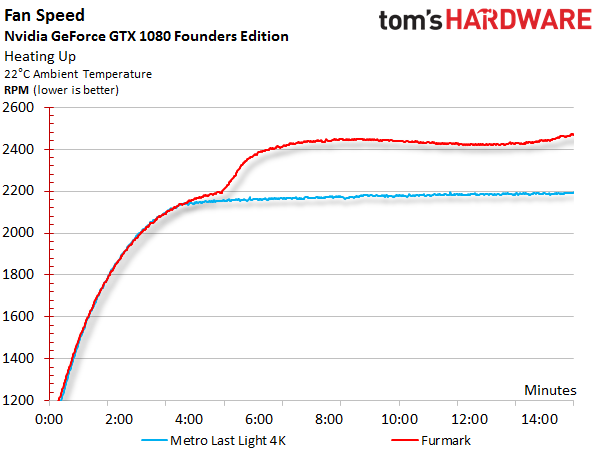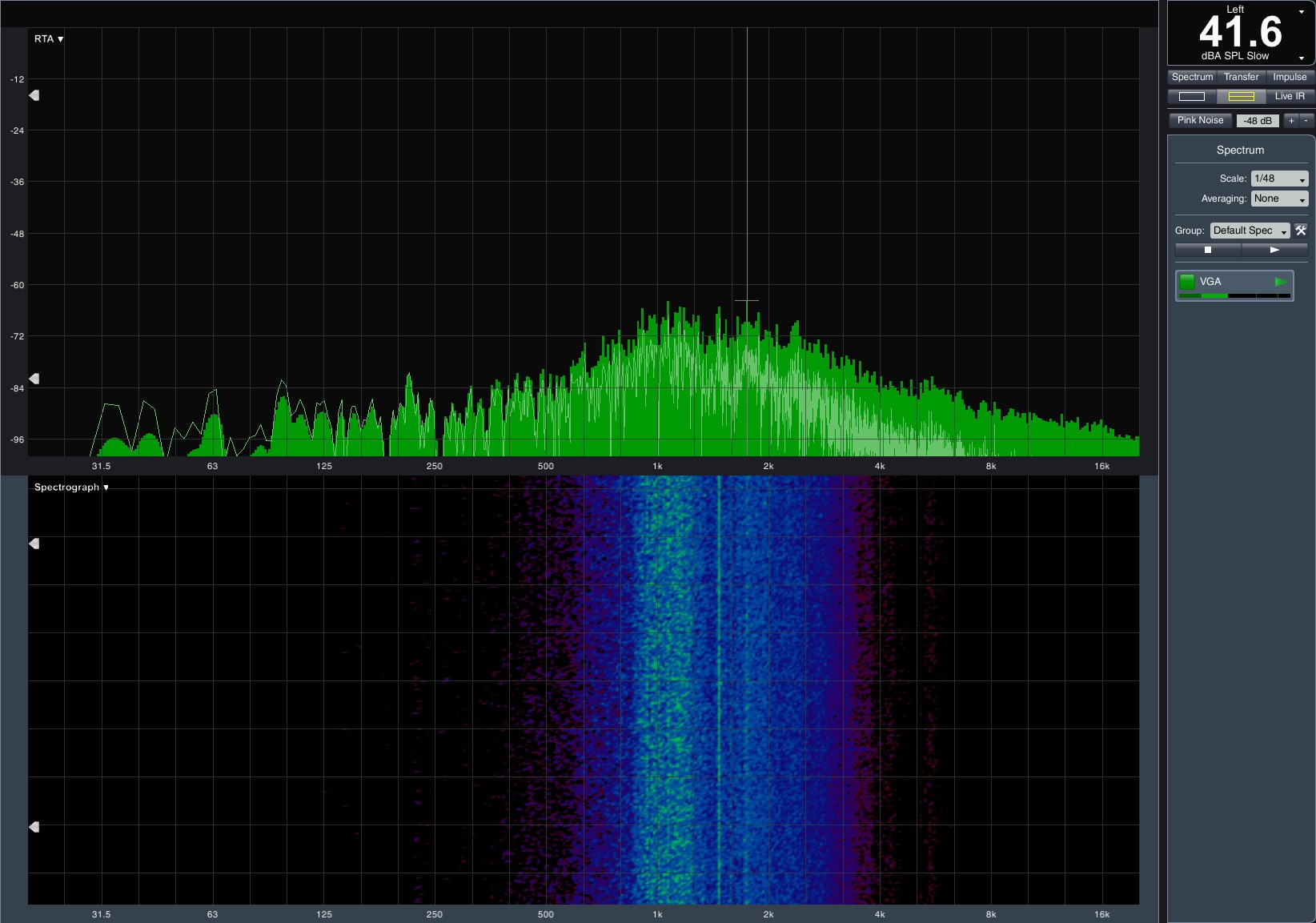Nvidia GeForce GTX 1080 Pascal Review
Temperature And Noise Results
Temperature And Clock Frequency
As Nvidia showed off the GeForce GTX 1080 at its press day in Austin, Texas, we kept asking ourselves how the card repeatedly showed up in demos at temperatures under 65 °C. In order to circumvent its thermal limit, we tried setting the fan to a 100% duty cycle, and that ended up being the simple solution.
In our standard setup with an ambient temperature of 22 °C, we measured 68 to 69 °C. In another room at 20 °C, and using a less demanding Full HD workload, we finally replicated Nvidia's 65 °C demo. The noise that's created isn't bad when you're in a large hall full of journalists and EDM blaring over the speakers. But it's much more apparent in an office.
And unfortunately, real-world temperatures after three minutes of warm-up look a lot different than what we saw during Nvidia's press day. It doesn't take long for the card to hit its temperature target and hover around 83 to 84 degrees Celsius. That number rises to 85 degrees during the stress test.
Focus on the overclocking run's orange line. At the beginning of our test, we registered a remarkable 2126MHz that finally stabilized at 2088MHz. Running at 1920x1080 not only saves 34W of power that isn't converted to heat, but it also facilitates GPU Boost rates above the 2.1GHz level.
The 1080 hits its temperature target by dropping the GPU's clock rate. During a gaming loop, it falls all the way down to its base frequency, leaving nothing left of GPU Boost. This gets even worse during our stress test, where the core clock dips below the 1607MHz that is supposed to be the GeForce GTX 1080’s floor.
Nvidia's direct heat exhaust cooler does do its job, but the GeForce GTX 1080 Founders Edition does face clear and restrictive boundaries that make overclocking completely pointless for sustained or challenging loads. Admittedly, the load’s a lot lower if you dial back to 1920x1080. But who buys a $700 graphics card for Full HD?
Idle Infrared Measurement
For more information, check out Measurement Science: Taking Accurate IR Thermal Readings.
Get Tom's Hardware's best news and in-depth reviews, straight to your inbox.
The hottest part of the GeForce GTX 1080 at idle is one of the voltage regulator's dual-channel MOSFETs. Its 38 degrees Celsius is mind; it's not like you'd expect a lot of waste heat from a card drawing less than 7W. Nvidia's new flagship putts along at human body temperature, in essence.
Gaming Infrared Measurement
Our measurement results and pictures show that the vapor chamber does its job well during gaming tests. The board temperature below the GPU is two to three degrees Celsius lower than what the GPU's internal temperature sensor reports. If the cooling solution was just a tad better, Nvidia's thermal limit wouldn’t be that big of a deal. So if push comes to shove, you can experiment with different fan profiles to make up the difference.
Stress Test Infrared Measurement
It’s notable that the voltage converters still don’t really play a role in the graphics card’s thermal performance during the stress test. Most of the heat comes from the GPU, and during our stress test there's plenty of thermal energy to go around. The board under the GPU hits the same temperature as the processor, and this heat spreads across the board. After a while, it reaches the memory modules and pushes them to, but not over, their thermal limit.
Practically speaking, very few people will run prolonged stress tests on a regular basis. In other words, this isn’t really going to be a problem.
Fan RPM And Noise
As usual, we conduct noise measurements in a sound-dampened test chamber using our custom-built silent test system. With this setup, we can measure noise starting at approximately 22 dB(A). The hardware keeps us from getting any lower. We’ll never even get remotely close to that kind of noise level with these graphics cards, though.
| Test System And Hardware | |
|---|---|
| Microphone | NTI Audio M2211 (with Calibration File, Low Cut at 50Hz) |
| Amplifier | Steinberg UR12 (with Phantom Power for Microphones) |
| System Hardware | Graphics Card Test System with Optimized Water Cooling- Intel Core i7-5930K @ 4.2GHz, Water-Cooled- Crucial Ballistix Sport, 4x 4GB DDR4-2400- MSI X99S XPower AC- 1x Crucial MX200, 500GB SSD (System)- 1x Corsair Force LS, 960GB SSD (Applications, Data)- be quiet! Dark Power Pro, 850W Power Supply Unit (PSU) |
| Water Cooling | - Alphacool VPP655 Pump (Undervolted)- Alphacool NexXxos CPU Cooler- Phobya Balancer- Alphacool 24cm Radiator- 2x 12cm Noiseblocker eLoop Fan @ 400 RPM |
| Software | Smaart v.7 |
| Measurement Chamber | Custom-Made Proprietary Measurement Chamber, 3.5 x 1.8 x 2.2m (LxDxH) |
| Measurement Position | Perpendicular to Center of Noise Source(s), Measurement Distance of 50cm |
| Measurement Data | - Noise Level in dB(A) (Slow), Real-time Frequency Analyzer (RTA)- Graphical Frequency Spectrum of Noise |
Let’s take a look at the 1080's noise level during the gaming loop, after it reaches its maximum temperature (see the temperature graphics above).
At 41.6 dB(A), Nvidia’s GeForce GTX 1080 does fairly well, especially if we compare it to lower-cost GeForce GTX 980 designs from board partners. This is also 2 dB(A) lower than the reference GeForce GTX 980.
During the torture test, noise rises to 46.8 dB(A). This is actually a nice result, seeing that it’s 3.2 dB(A) lower than the GeForce GTX 980.
The 1080's acoustic profile is really pleasant. It’s a nice broad whooshing/airflow noise, and the fan’s motor can never really be picked out. This is a lot better than the cheap axial fans that AMD used to put on its reference designs (and that some partners still use). In comparison, the Nvidia GeForce GTX 1080’s noise is tolerable.
Bottom Line
The cooling solution’s not bad, but the GeForce GTX 1080 does take a performance hit when it runs into its thermal limit. We’re looking forward to the partners’ solutions, which we expect to both be quieter and provide better cooling.
Current page: Temperature And Noise Results
Prev Page Power Consumption Results Next Page Conclusion-
JeanLuc Chris, were you invited to the Nvidia press event in Texas?Reply
About time we saw some cards based of a new process, it seemed like we were going to be stuck on 28nm for the rest of time.
As normal Nvidia is creaming it up in DX11 but DX12 performance does look ominous IMO, there's not enough gain over the previous generation and makes me think AMD new Polaris cards might dominate when it comes to DX12. -
slimreaper Could you run an Otoy octane bench? This really could change the motion graphics industry!?Reply
-
F-minus Seriously I have to ask, did nvidia instruct every single reviewer to bench the 1080 against stock maxwell cards? Cause i'd like to see real world scenarios with an OCed 980Ti, because nobody runs stock or even buys stock, if you can even buy stock 980Tis.Reply -
cknobman Nice results but honestly they dont blow me away.Reply
In fact, I think Nvidia left the door open for AMD to take control of the high end market later this year.
And fix the friggin power consumption charts, you went with about the worst possible way to show them. -
FormatC Stock 1080 vs. stock 980 Ti :)Reply
Both cards can be oc'ed and if you have a real custom 1080 in your hand, the oc'ed 980 Ti looks in direct comparison to an oc'ed 1080 worse than the stock card in this review to the other stock card. :) -
Gungar @F-minus, i saw the same thing. The gtx 980Ti overclocks way better thn 1080, i am pretty sure OC vs OC, there is nearly no performance difference. (disappointing)Reply -
toddybody Reply@F-minus, i saw the same thing. The gtx 980Ti overclocks way better thn 1080, i am pretty sure OC vs OC, there is nearly no performance difference. (disappointing)
LOL. My 980ti doesnt hit 2.2Ghz on air. We need to wait for more benchmarks...I'd like to see the G1 980ti against a similar 1080. -
F-minus Exactly, but it seems like nvidia instructed every single outlet to bench the Reference 1080 only against stock Maxwell cards, which is honestly <Mod Edit> - pardon. I bet an OCed 980Ti would come super close to the stock 1080, which at that point makes me wonder why even upgrade now, sure you can push the 1080 too, but I'd wait for a price drop or at least the supposed cheaper AIB cards.Reply -
FormatC I have a handpicked Gigabyte GTX 980 Ti Xtreme Gaming Waterforce at 1.65 Ghz in one of my rigs, it's slower.Reply









